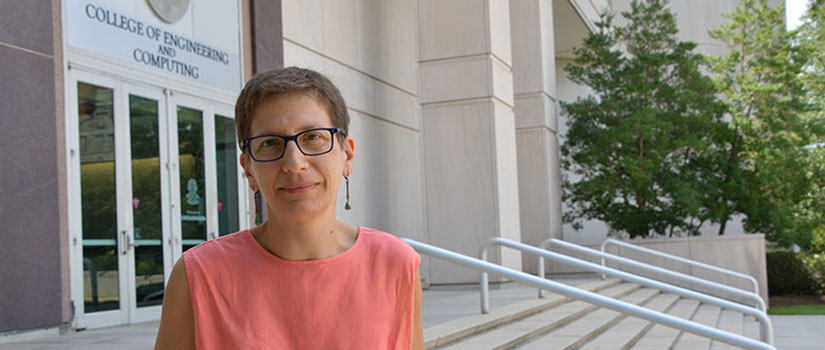Enrica Viparelli's research provides valuable insight on how rivers and riparian ecosystems change.
Civil and Environmental Engineering Professor Enrica Viparelli specializes in sediment transport, erosion and deposition. She grew up in Italy and came to the University of South Carolina after a postdoctoral research experience at the University of Illinois Urbana-Champaign. She is currently involved in national and international multidisciplinary projects, including one in Nepal that is protecting endangered Himalayan tigers.
Viparelli and her colleagues study how natural systems behave and evolve, and how humans impact these systems. They have been awarded over six million dollars of funding for their research to improve water resource engineering practices.
What originally drew you to water resource engineering?
I think that the interest came from a high school project where we simulated the European Parliament, and I was responsible for the Committee on Agriculture and Rural Development. We ended up winning the national selection and going to the European meeting representing Italy. Reading those documents introduced me to the issue of land and water development in rural areas.
Why is it so important to model changes in the sedimentation of rivers?
You need to be aware that if you build something like a dam, it’s going to have an impact on the environment. Many of the problems that we have today with erosion and flooding are easy to blame on climate change, which is definitely a problem, but there's also a landscape that has been messed up by humans. The response to the two issues is different, and it's important to distinguish between them so we can react responsibly.
What is the danger of overlooking the long-term effects of construction projects that interfere with the behavior of rivers?
Typical engineering time scales are 20 to 25 years for large projects, hardly ever 50 or more. The disaster, however, can come decades after the project's completion because the river's response is slow. You should consider the future impact beforehand, if you are able to predict it, so you can design in a sustainable way without depleting natural resources and hurting communities downstream.
Can you talk a little bit about the project you worked on that was funded through the USC Advanced Support for Innovative Research Excellence (ASPIRE) program?
Everybody blames the flooding in Charleston on climate change, but there's more to it. There’s been land development in the area that has altered the local hydrology. In addition, the estuary that was originally fairly shallow has become a deep, massive port.
The ASPIRE project was a collaborative effort with physical oceanographer [Alexander] Yankovsky and geomorphologist [Raymond] Torres at the School of the Earth, Ocean and Environment. We studied how changes in estuary geometry impacted the amplitude of tides and storm surges, and if increased flooding may be related to harbor development and human modification of the Cooper River.
One of your projects has its headquarters here on the Congaree River. Does working on local projects impact the relationship you have with your surroundings?
You have to study geology and history to learn how natural resource management practices have changed over time and understand how humans have impacted rivers and floodplains. In these studies, you end up reading about how local communities have developed, how agricultural practices have changed and the impact of technological advancements. This allows you to have a better understanding of the place where you live.
You’re also currently working on a project that aims to protect tigers in the Himalayan mountains. How do natural resource management and Himalayan tigers connect?
In Nepal, they are planning to build a series of dams to regulate flow on a river in the Ganges basin. The question is how the construction of this dam is going to impact the ecosystem all the way up the food chain to the Himalayan tiger, which is an endangered species. When you regulate the flow, the shape of the river changes. Then, plants are going to change and animals are going to respond to the change in landscape and vegetation.
Can you describe how building a dam can impact the fish species that live in the river?
If you close a dam, you block all the coarse sediment. Gravel and sand get trapped, so the channel will tend to erode. Erosion changes how water and sediment are distributed downstream, and the riverbed changes in response. The fish habitat may deteriorate over time and become unhealthy for some aquatic species.
A lot of your work has applications in environmental conservation and climate change. What do you think needs to change to make people more interested in environmental issues?
One reason why I think there is a problem with climate change denial is how the message is presented and conveyed. We need to be serious in reporting what we know and don't know be willing to learn from the experience of those that maybe don't have degrees but know how natural systems work because they have been living in areas experiencing negative effects of climate change. We have to work with communities and be aware of what their needs and constraints are and not impose from higher up, because that doesn't work.
